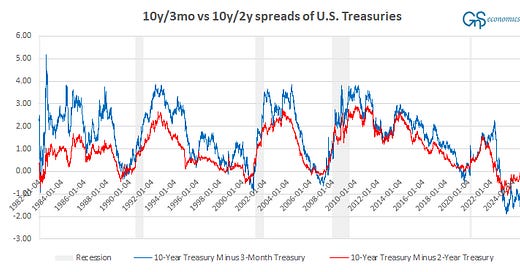Forecasts:
Is Ukraine a “sacrificial lamb”?
The U.S. recession looks to begin soon.
There’s a notable risk of U.S. stagflation.
The role of Ukraine in the Peak Escalation
On January 11, we issued two warnings:
There will be attempts to post-pone, or completely derail the peace process in Ukraine during H1 2025.
If this (peace in Ukraine) comes to be, as we suspect it eventually will, another front with Russia will be opened somewhere in the axis of Poland/Belarus, Baltics or the Nordics, shortly after.
On Friday, Tuomas noted that: European “peacekeeping” force can be tried on the former and, e.g., disrupting the operation of Russian ‘shadow fleet’ in the Baltic Sea to the latter.
The Times reports that British PM Keir Starmer is planning to deploy over 10000 soldiers into Ukraine, as a ‘peacekeeping force’. According to the source, over 35 countries would have pledged support as the “Coalition of the willing”. Moreover, reportedly this coalition would be entering “an operational phase”. This implies that political decisions would already have been made, which does not surprise us, because it fits our Peak Escalation hypothesis so perfectly.
President’s Putin and Trump held a (lengthy) phone conversation on Tuesday. They reportedly agreed on “immediate” ceasefire on energy and infrastructure but the first reports of strikes of energy infrastructure, on both sides, appeared shortly after. There’s now a grave threat that President Trump is (truly) edging close to the failure, we warned about. The security guarantees demanded by Kiev and Moscow could not be further apart (with the exception of Kiev actually demanding nuclear weapons). President Trump is giving positive statements on the progress towards peace, but we fail to see only marginal progress, if any.
Tuomas published an important piece regarding this on Tuesday. It looks that fascist factions are running Ukrainian politics, after all. This was quite of a surprise to us, and it yields some serious ramifications concerning the peace process. If any larger concessions towards Russia risk a civil war, or a paramilitary coup, how can there be any progress towards peace? Dr. Petro outlined this clearly:
[…] these far-right nationalist factions are not merely fringe elements but are well-armed and deeply entrenched within Ukraine’s power structures. They have, time and again, demonstrated their ability to derail political decisions through intimidation and violence. He points to the Minsk Agreements as a prime example—both President Petro Poroshenko and President Volodymyr Zelensky initially pursued peace negotiations, only to backtrack under pressure from nationalist groups that refused to accept any compromise with Russia.
What would become of a ceasefire, if Presidents Putin and Trump would be able to hammer through something resembling it, to appease each other and each other’s constituencies in the coming weeks? Conditions that would need to be attached to it are almost inconceivable. Ceasefire would need to address two highly opposing aims:
Ukraine seeks for a NATO membership (even though it was taken off the table) and western military support, effectively European troops on the ground.
Kreml seeks for de-militarized and “de-nazified” Ukraine.
This means that any ceasefire and negotiations for peace require heavy concessions from one side. If Kreml would budge and allow European “peacekeeping” troops to Ukraine, tensions would continue to increase until the war would flare up again, but this time with European troops directly involved. If President Zelenskyy would capitulate, national factions could enact a coup derailing the whole process, with the likely support of the Coalition of the willing.1
There’s a road to peace in Ukraine, though. It’s full capitulation on Ukraine, which is only achievable through the surrender of the AFU. The question is, can the AFU leadership do this, without risking a civil war and a war within the AFU?
Thus, we issue a warning that, if a ceasefire/truce will be established between Russia and Ukraine, which does not include capitulation and de-militarization of Ukraine, the war will return ‘with a vengeance’ on a later date.
The fact that Ukrainian far-right nationalistic groups were not dismantled and marginalized, like it was done elsewhere in Europe, makes Ukraine a perfect candidate for the perpetual war, the NATO Deep State and military-industrial complex are likely to seek for. One has to ask, was this even planned to go this way? That is, was Ukraine left corrupted and run by fascists factions just to wait for the unyielding NATO enlargement to reach her? This is rather conspiratorial but what can we really discredit, outright, in these times?
Peak Escalation was a mere worst-case scenario, when Tuomas first introduced it. Now, because it has such a high forecasting power, it has become our working hypothesis. It states that the forces operating mostly in the background are pushing us (the world) towards a global conflict. The question we have not been able to answer in a satisfactory manner, is why? Why is it being driven? Money definitely plays a role, but because those pushing for the global conflict are clearly flirting with a nuclear holocaust, it cannot be the only explanation. And in such an open-ended scenario, we have to acknowledge the possibility that Ukraine was prepared to be this “sacrificial lamb”, destined to set Europe ablaze (again). Tuomas will speculate more with these possible dark motives, at a later date.
The onset of U.S. recession is close
There has been a development with the U.S. yield curves. The 10y/3mo curve has fallen back to negative, i.e., it has ‘re-inverted’. This is as a strong recession signal.
Keep reading with a 7-day free trial
Subscribe to GnS Economics Newsletter to keep reading this post and get 7 days of free access to the full post archives.




